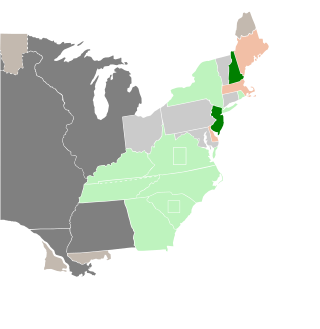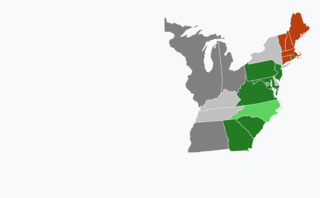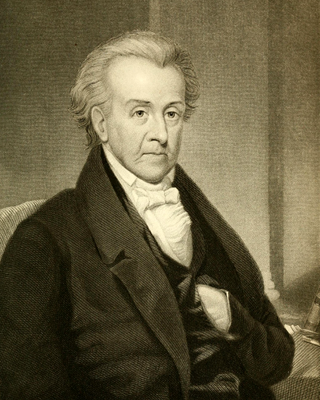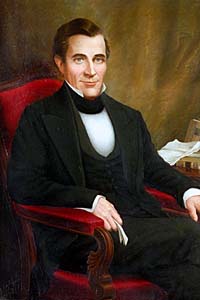
The 1800 United States presidential election was the fourth quadrennial presidential election. It was held from October 31 to December 3, 1800. In what is sometimes called the "Revolution of 1800", the Democratic-Republican Party candidate, Vice President Thomas Jefferson, defeated the Federalist Party candidate and incumbent, President John Adams. The election was a political realignment that ushered in a generation of Democratic-Republican leadership. This was the first presidential election in American history to be a rematch.

The 1802–03 United States House of Representatives elections were held on various dates in various states between April 26, 1802 and December 14, 1803. Each state set its own date for its elections to the House of Representatives, either before or after the first session of the 8th United States Congress convened on October 17, 1803. They occurred during President Thomas Jefferson's first term in office.

The 1798–99 United States House of Representatives elections were held on various dates in various states between April 24, 1798 in New York and August 1, 1799 in Tennessee. Each state set its own date for its elections to the House of Representatives, with some after the official start of the 6th United States Congress on March 4, 1799, but before the start of the first session of this Congress in Philadelphia on December 2, 1799. These elections were held during President John Adams term. It was the last congressional session before the move to the new capital at Washington, D.C. Elections were held for all 106 seats, representing 16 states.

The 1804–05 United States Senate elections were held on various dates in various states. As these U.S. Senate elections were prior to the ratification of the Seventeenth Amendment in 1913, senators were chosen by state legislatures. Senators were elected over a wide range of time throughout 1804 and 1805, and a seat may have been filled months late or remained vacant due to legislative deadlock. In these elections, terms were up for the senators in Class 2.

The 1806–07 United States Senate elections were held on various dates in various states. As these U.S. Senate elections were prior to the ratification of the Seventeenth Amendment in 1913, senators were chosen by state legislatures. Senators were elected over a wide range of time throughout 1806 and 1807, and a seat may have been filled months late or remained vacant due to legislative deadlock. In these elections, terms were up for the senators in Class 3.

The 1802–03 United States Senate elections were held on various dates in various states. As these U.S. Senate elections were prior to the ratification of the Seventeenth Amendment in 1913, senators were chosen by state legislatures. Senators were elected over a wide range of time throughout 1802 and 1803, and a seat may have been filled months late or remained vacant due to legislative deadlock. In these elections, terms were up for the senators in Class 1.

The 1802 Rhode Island gubernatorial election was an election held on April 21, 1802, to elect the Governor of Rhode Island. Arthur Fenner, the incumbent governor and Democratic-Republican candidate, beat the Federalist candidate William Greene with 66.28% of the vote.

United States gubernatorial elections were held in 1800, in 11 states, concurrent with the House, Senate elections and presidential election.

United States gubernatorial elections were held in 1802, in 12 states, concurrent with the House and Senate elections.

The 1802 New Hampshire gubernatorial election took place on March 9, 1802. Incumbent Federalist Governor John Taylor Gilman won re-election to a ninth term, defeating Democratic-Republican candidate, former Governor and U.S. Senator John Langdon.

The 1802 Connecticut gubernatorial election took place on April 8, 1802. Incumbent Federalist Governor Jonathan Trumbull Jr. won re-election to a fifth full term, defeating Democratic-Republican candidate Ephraim Kirby.

The 1812 New Hampshire gubernatorial election was held on March 10, 1812.

The 1813 Connecticut gubernatorial election took place on April 12, 1813.

The 1810 Connecticut gubernatorial election took place on April 9, 1810.

The 1811 Connecticut gubernatorial election took place on April 8, 1811.

The 1802 South Carolina gubernatorial election was held on 8 December 1802 in order to elect the Governor of South Carolina. Democratic-Republican candidate and member of the South Carolina House of Representatives from Clarendon District James Burchill Richardson defeated fellow Democratic-Republican candidate and incumbent Lieutenant Governor of South Carolina Richard Winn, as well as Federalist candidate, former Governor of South Carolina and 1796 presidential election Vice Presidential nominee Thomas Pinckney and Democratic-Republican candidate John Gaillard, after receiving a majority of votes in a General Assembly secret ballot vote.

The 1801 Georgia gubernatorial election was held on 6 November 1801 in order to elect the Governor of Georgia. Democratic-Republican candidate and former United States Senator from Georgia Josiah Tattnall defeated Federalist candidate and former member of the U.S. House of Representatives from Georgia's at-large congressional district Thomas P. Carnes and former Democratic-Republican Governor Jared Irwin in a Georgia General Assembly vote.

The 1803 Georgia gubernatorial election was held on 24 November 1803 in order to elect the Governor of Georgia. Incumbent Democratic-Republican Governor John Milledge won re-election against Solomon Wood in a Georgia General Assembly vote.

The 1805 Georgia gubernatorial election was held on 4 November 1805 in order to elect the Governor of Georgia. Incumbent Democratic-Republican Governor John Milledge won re-election in a Georgia General Assembly vote as he ran unopposed.

The 1807 Georgia gubernatorial election was held on 10 November 1807 in order to elect the Governor of Georgia. Incumbent Democratic-Republican Governor Jared Irwin defeated Federalist candidate and former member of the U.S. House of Representatives from Georgia's at-large congressional district Benjamin Taliaferro in a Georgia General Assembly vote.



















